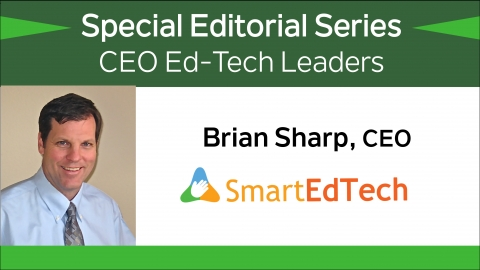SmartEdTech: Designs Centralized Environment for Digital Learning
12-19-2018 By Kenna McHugh, Learning Counsel Writer

Brian Sharp became the CEO of SmartEdTech over two years ago. With 19-years in educational technology, his career includes working at Apple, PowerSchool, Apex Learning, Kickboard and Rethink during their startup phases. “We all know that textbooks are fading. Digital content is the future. We hope to stay close to the cutting edge of that evolution. I have always had a passion for helping students and the teachers that mold them. Nothing is ever more enjoyable than doing a classroom walkthrough and seeing your product making a difference in the future of a child,” shares Sharp.
SmartEdTech is a mobile learning platform aggregator for PreK-12 grades. The startup platform creates a centralized environment for digital learning content, enabling teachers to the source, assign, and report on student progress in different education apps within one easy-to-use platform. The company's goal is solving two problems: the gap between data to action and the digital divide in education. “According to research, teachers struggle to bridge the gap from data to action. We know that digital education is booming as evidence of that last year 87% of districts said they planned to increase spending on digital curriculum following a 25% jump in the year prior,” explains Sharp.
SmartEdTech is designed to help teachers and students take action. “Much of the adoption you will see is web-based content, often in the form of OER. While we do offer an extensive library of web content that covers 95% of CCSS (math and ELA) plus Next Gen Science standards, we are also very focused on the digital divide.”
As a part of E-rate modernization in 2014, the FCC set a bandwidth goal for schools of 1Mbps per student by 2018 to support the bandwidth requirements of classroom-based digital learning. Sharp warns only 28% of the school districts and 15% of the 1,000 largest school districts met the required bandwidth. “Take note that there are still 12-million kids (mostly low income and ethnically diverse) without internet access at home, which has caused 40% of districts to discourage web-based homework assignments altogether.”
Sharp knows this challenge is not just in rural communities, as 42 of the top 50 districts exceed 45% free and reduced lunch and only 5 of these districts have student populations that are predominantly white and Asian versus black and Hispanic. Detroit is a prime example of a large metro where the majority of students do not have ample internet at home that could support the use of web-based instructional resources.
According to Sharp, administrators have spent years implementing programs to close the achievement gap, but the digital divide is a real threat to that progress. SmartEdTech helps solve this problem with a library of thousands of native or mobile education apps that are aligned to standards and vetted for instructional quality. “Now, teachers can not only source recommended web content to support student learning concepts but can feel confident that they can also assign digital instruction that can be used offline in classrooms or at home.”
As with most new EdTech companies, SmartEdTech’s biggest challenge is awareness. “Until we fully present our solution to the district and school leaders, we are not a priority conversation to them,” explains Sharp.
The company’s primary focus is working hard to connect with the software that teachers use every day and closing the gap between data to action. “Imagine a teacher has just given an exit assessment on the day’s instruction. She is looking at the data and sees that 3 of the students did not comprehend the concepts. What if through that assessment software there was a ‘now what’ button that they could push that would bring up recommended digital content that aligned to the standards assessed? With a click of the button, they assign the content to those three students as homework that night keep them on pace with their peers,” describes Sharp.
As a small company, Sharp knows their best chance at survival is to find forward-thinking EdTech companies that complete the first part of this solution and partnering with them. “Using APIs and potentially a white label offering, we can become a core selling feature for them to help solve very real problems facing the next step in the evolution of digital learning.”
“With a startup, sometimes you have a big vision idea of a solution that can help solve real problems. Initially, for us, extending our functionality to create the first central hub for mobile learning apps.”
Sharps points out that in an environment where teachers need help narrowing down the 750,000 mobile education apps into a manageable list. They then select from the list and assign to their students. “We built that and started to share it with the big device companies to consider partnering with us. The success story came last June when Apple announced a product that was proprietary to the iPad that did something very similar. I took it as validation.”
Now, Google is developing something similar. “They are giants, but they cannot be as responsive to the needs of customers. I know this because I have worked in big companies before,” declares Sharp.
SmartEdTech's solution has continued to evolve matching the digital learning needs of teachers and students over the past year. “We’re first to the market and have stayed in front of the continued development for the needs of classrooms. Our story has now evolved to being an enabler for other EdTech solutions to white label embed into their products a technology that rivals Apple and Google technologies. Sounds like a success to me,” concludes Sharp.
Article Published in : Thelearningcounsel.com